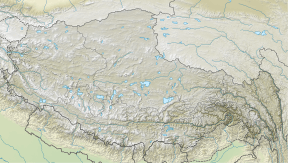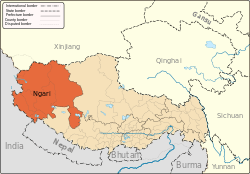Burang Town
Burang (Tibetan: སྤུ་ཧྲེང་རྫོང ,[2] IPA: puʂeŋ; simplified Chinese: 普兰镇; traditional Chinese: 普蘭鎮; pinyin: Pǔlán Zhèn) , known as Purang in Tibetan, is a town which serves as the administrative center of Burang County, Ngari Prefecture of the Tibet Autonomous Region (TAR), China.[3] The town lies at 4,755 metres (13,205 feet) altitude in the valley of the Sarayu Karnali River. As of 2010, the town has a population of 6,047.[1] To the south are Gurla Mandhata (Mount Namonanyi) and the Abi Gamin ranges. Lake Manasarovar and Mount Kailash are to the north. This region is the mythological and actual river nexus of the Himalaya with sources of the Indus, Ganges and Yarlung Tsangpo/Brahmaputra all within 110 kilometres (70 mi) of Burang.
Burang
| |
|---|---|
Town | |
 Burang Location within Tibet Autonomous Region | |
| Coordinates (Burang Town government): 30°17′10″N 81°10′37″E | |
| Country | People's Republic of China |
| Autonomous region | Tibet |
| Prefecture | Ngari |
| County | Burang |
| Elevation | 4,755 m (13,205 ft) |
| Population (2010)[1] | |
| • Total | 6,047 |
| • Major Nationalities | Tibetan |
| • Regional dialect | Tibetan language |
| Time zone | UTC+8 (CST) |
Etymology
The Tibetan name of the town (spu hreng) is a corruption of the Zhang-zhung words pu hrang, meaning 'horse head'. Nepalese and Indians call the town Taklakot (from Tibetan 'Takla Khar').
Saryu Karnali River's Peacock Mouth[4] source is glaciers on the northern slopes of the Himalaya 50 kilometres (30 mi) NW of Burang. The Lion Mouth source of the Indus is 20 kilometres (12 mi) east of Mount Kailash and the Elephant Mouth is the source of the Sutlej. Lake Manasarovar is just 2 km from few of the Sarayu heads, and has an ephemeral connection to Rakshastal. The Horse Mouth source of the Yarlung Tsanpo (Brahmaputra) is about 90 km. (55 mi.) SE of Lake Manasarovar.
History and religion
Burang is an ancient trading post. It is said to be the place where Sudhana, a previous incarnation of the Buddha, lived.[5]
On a cliff above the town was the large ancient fort of Tegla Kar (Lying Tiger Fort) and Simbiling Monastery (both totally destroyed in 1967 by Chinese artillery during the Cultural Revolution, but the monastery has since been partially restored). Beneath them is the Tsegu Gompa or the "Nine-Storey Monastery" which was probably originally a Bön establishment.[6] Tsegu covers many terraces and may be reached by ladders, and contains many unique and ancient wall-painting, darkened from centuries of smoke.[7]
It seems that the Tegla kar (Lying Tiger fort) was built during the Zhangzhung dynasty which was conquered by the Tibetan king Songtsen Gampo in the early 7th century CE. It became the main fort of the Burang Kingdom, in the 10th century under King Kori, one of the two sons of Tashi Gon, King of the Guge Kingdom. The Burang kingdom is believed to have ended in the 15th century.
Burang is the gateway town for travel to Mount Kailash and Lake Manasarovar to the north. These are important destinations for Bon, Buddhist, Hindu, Jain and even New Age pilgrims. Traditional cosmology designates Mount Kailash the center of the universe. Great religious merit is attributed to parikrama around the mountain, and to bathing in Lake Manasarovar.
Administrative divisions
The town is divided into six village-level divisions: Jirang Neighborhood Committee, Duoyou Village, Rengong Village, Xide Village, Kejia Village, and Chide Village.[1] The town's government is seated in the Jirang Neighborhood Committee.[1]
Transport
Road
National Road S207 begins in Burang, heading NE 65 kilometres (40 mi) past Lake Rakshastal and Manasarovar to China National Highway 219.
Border crossings
Burang is near the borders with India and Nepal. A road leads some 56 kilometres (35 mi) down the Karnali River to the border crossing at the village of Xie'erwa (Tibetan: Sher) into Hilsa in Nepal (Humla District, Karnali Zone) where a historic trail and now a rough motor road continuing to Simikot. There is also a border crossing into India (Pithoragarh district, Uttarakhand State) over Lipulekh Pass in Darchula District of Nepal. Beyond the pass the foot trail continues to Dharchula.
Geography and climate
Burang has a cold arid climate (Köppen BWk), with long, cold winters and mild summers. The normal monthly mean temperature ranges from −7.6 °C (18.3 °F) in January to 14.4 °C (57.9 °F) in July, and the annual mean is 3.64 °C (38.6 °F). Annual precipitation is only around 150 mm (5.9 in).
| Climate data for Burang, 3,900 m (12,795 ft) amsl (1981−2010 normals) | |||||||||||||
|---|---|---|---|---|---|---|---|---|---|---|---|---|---|
| Month | Jan | Feb | Mar | Apr | May | Jun | Jul | Aug | Sep | Oct | Nov | Dec | Year |
| Average high °C (°F) | 0.2 (32.4) |
1.2 (34.2) |
5.2 (41.4) |
10.1 (50.2) |
14.9 (58.8) |
19.2 (66.6) |
21.3 (70.3) |
20.7 (69.3) |
17.9 (64.2) |
12.2 (54.0) |
7.7 (45.9) |
3.6 (38.5) |
11.2 (52.2) |
| Daily mean °C (°F) | −7.6 (18.3) |
−6.2 (20.8) |
−2.0 (28.4) |
2.9 (37.2) |
7.6 (45.7) |
12.1 (53.8) |
14.4 (57.9) |
13.9 (57.0) |
10.8 (51.4) |
4.1 (39.4) |
−1.1 (30.0) |
−5.2 (22.6) |
3.6 (38.5) |
| Average low °C (°F) | −14.2 (6.4) |
−12.8 (9.0) |
−8.4 (16.9) |
−3.2 (26.2) |
1.3 (34.3) |
5.9 (42.6) |
8.8 (47.8) |
8.4 (47.1) |
4.7 (40.5) |
−2.7 (27.1) |
−8.2 (17.2) |
−12.1 (10.2) |
−2.7 (27.1) |
| Average precipitation mm (inches) | 9.5 (0.37) |
12.4 (0.49) |
20.3 (0.80) |
12.5 (0.49) |
11.1 (0.44) |
7.1 (0.28) |
20.8 (0.82) |
24.4 (0.96) |
14.3 (0.56) |
8.6 (0.34) |
4.0 (0.16) |
5.5 (0.22) |
150.5 (5.93) |
| Average relative humidity (%) | 42 | 46 | 47 | 46 | 47 | 51 | 59 | 61 | 56 | 43 | 35 | 35 | 47 |
| Source: China Meteorological Administration[8] | |||||||||||||
References
- 普兰镇. xzqh.org (in Chinese). 2016-04-05. Archived from the original on 2020-06-17. Retrieved 2020-06-17.
- "Ngari prefecture". Geographical names of Tibet AR (China). Institute of the Estonian Language. 2018-06-03. Retrieved 9 January 2020.
- 普兰县概况地图. xzqh.org (in Chinese). 2016-03-01. Archived from the original on 2020-06-17. Retrieved 2020-06-17.
- .Snelling, John. (1990). The Sacred Mountain: The Complete Guide to Tibet's Mount Kailas. 1st edition 1983. Revised and enlarged edition, including: Kailas-Manasarovar Travellers' Guide. Forwards by H.H. the Dalai Lama of Tibet and Christmas Humphreys, pp. 74, photo on p. 238. East-West Publications, London and The Hague. ISBN 0-85692-173-4.
- Tibet Handbook, p. 350. (1999). Edited by Sarah Thorowgood. Passport Books, Chicago. ISBN 0-8442-2190-2.
- Allen, Charles. (1999) The Search for Shangri-La: A Journey into Tibetan History, p. 55. Little, Brown and Company. Reprint: 2000 Abacus Books, London. ISBN 0-349-11142-1.
- Tibet Handbook, p. 351. (1999). Edited by Sarah Thorowgood. Passport Books, Chicago. ISBN 0-8442-2190-2.
- 中国气象数据网 - WeatherBk Data (in Chinese). China Meteorological Administration. Retrieved 2020-04-21.
External links
- Purang: a region joining Tibet, Nepal, and India (Kailashzone Charitable Foundation)
- Photos of Taklakot
